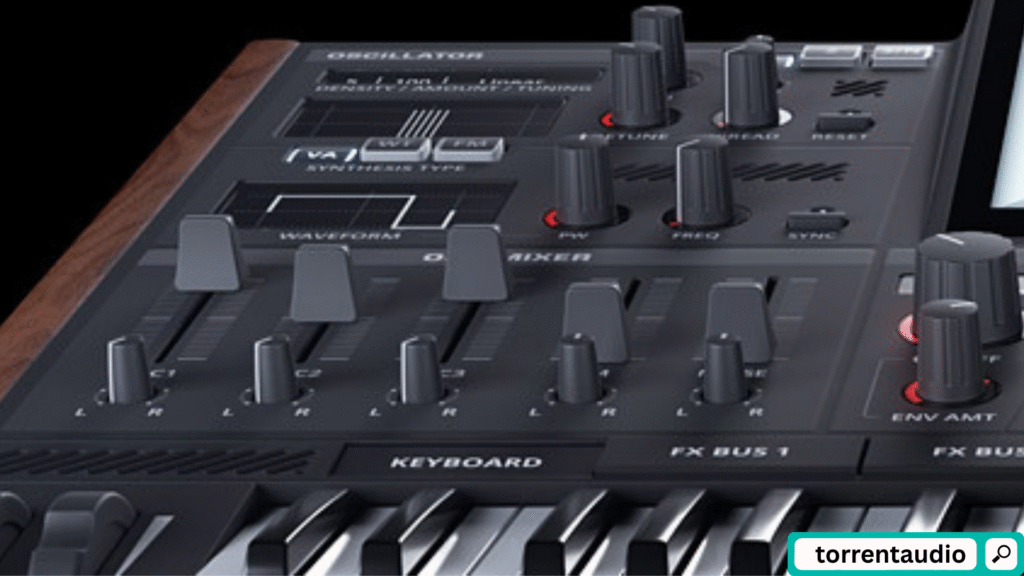
Audio Synapse’s flagship soft synth for producers seeking contemporary strength without sacrificing that tactile, melodic feel is DUNE (Differential Unison Engine). DUNE, which is based on a very effective unison architecture, combines virtual analog, wavetable, and FM/PM synthesis into a single, integrated instrument that allows you to switch between powerful basses, warm pads, and theatrical soundscapes with innovative leads in a single composition. The refined effects rack glues every sound into a patch that is ready for recording, the arpeggiator generates rapid ideas, and the modulation system is sophisticated yet approachable. DUNE has a broad sweet spot and minimal CPU impact on Windows PCs, making it ideal for scoring, creating club hits, or composing sound for video games.
Feature Highlights:
- Hybrid sound engine: Use DUNE’s differential unison to stack many oscillators to create massive, movement-rich tones that remain focused in a mix, then combine VA, wavetable, and FM/PM in each voice.
- MSEGs and envelopes: You may create intricate modulation shapes for changing pads, risers, plucks, and animated textures using multi-stage envelopes.
- Variable filters: A wide range of traditional and timeliness filter types, including ladder, state-variable, and others, along with serial/parallel itinerary for precisely sculpting harmonics.
- Arpeggiator and step sequencer: Set up chord modes, ratchets, and rhythmic patterns to quickly create hooks.
- Macro controls: Use a single knob to assign important parameters to macros, allowing them to implement or computerize large, musical adjustments.
- Studio-quality effects: pressing, EQ, reverb, misrepresentation, delay, phaser, chorus, and more, all in an easy-to-follow range for fast varnish.
- Find sounds by author, character, or type in the preset browser with tags. Favor and arrange banks for easy recall.
- Scalable GUI: Make lengthy sessions easier on the eyes by resizing the interface to fit any display.
- Multicore optimization: Effective CPU use even with multilayer patches and thick unison stacks.
What’s New 2025:
- Increased wavetable content: New factory tables and patches that provide you with production-ready starting points and include modern drill, afro-fusion, synthwave, cinematic, and techno styles.
- Improved oscillator algorithms: clearer top-end on bright leads and bells due to smoother high-frequency response and better anti-aliasing at high unison counts.
- Upgrades to Arp include scale-snap, per-step probability, and new play modes that let you draw melodic sequences that seem natural while remaining in key.
- Quality-of-life modulation: Faster drag-and-drop assignments, more transparent matrix routing, and visible feedback on sources and targets to expedite sound composition.
- Updated reverb and tape-style delay models with improved diffusion and saturation behavior, along with pre/post distortion options, are part of the effects update.
- Windows performance tuning: Large templates operate more smoothly during hectic DAW sessions thanks to improved multicore distribution and less GUI overhead.
Quick Guide:
- Load an initial patch: To hear changes, start with a simple preset.
- Create the main tone by blending VA for traditional warmth with wavetable for a contemporary edge. Modestly raise the unison voices (4–8) and detune lightly for mud-free breadth.
- Shape with filters: Use a clean SVF for expressive sweeps or a ladder model for heavy bass/lead tones. To have brightness follow pitch, use key-tracking.
- Include motion: Assign amplitude to envelope 1 and filter sweeps to envelope 2. For soft movement, use an LFO in pan or wavetable position; for rhythmic effects, sync to tempo.
- Draw using MSEGs to add per-note pluck articulation, create risers, or develop pads by creating ramps, steps, or intricate curves.
- Program the arp: For vibrant, human changes, choose a scale, establish a pace and gate, and then experiment with the new probability every step.
- Effects-wise, polish with a little chorus for breadth, delay for depth, and a plate or hall reverb to fill the room. To suit the mix, use the compressor/EQ last.
- Macro it: For expressive performance and rapid automation, map your MIDI controller to macros that have cutoff, unison detune, and effect mix assigned to them.
- Save wisely: When deadlines are approaching, tag your patches with something like “Pad – Warm – Cinematic” so they appear right away.
System prerequisite:
- Open software: 64-bit Windows 10 or Windows 11
- Formats for frontend: VST3 (and VST2, if your host supports them)
- Processor: A contemporary 64-bit SSE2 processor with four cores or more is advised for intensive unison
- RAM: 4 GB at the very shorter; for major projects, 8 GB or more is advised.
- Storage: around 300–500 MB for factory content and plugins (with more room for extensions)
- Presentation: at least 1280 x 800; scalable user boundary supports HiDPI/4K
- The myriad is a 64-bit DAW that is compatible such as FL Studio, Ableton Live, Cubase, Studio One, or Reaper.
Download Steps:
- Visit an authorized reseller or the Synapse Audio website: Steer clear of third-party mirrors as they may include hazardous or out-of-date installers.
- Select the DUNE version for Windows: Check if your DAW supports the screenlet format (VST3 is generally supported).
- Create an account or log in: This ensures that you can always access your license, updates, and expansions.
- Finish the purchase or, if one is available, see a demo. Demos are excellent for assessing workflow and CPU consumption during your sessions.
- Get the installer here: Before installation, shut down your DAW and save it to a recognized place.
- Launch the installation in administrator mode: Choose the plugin paths or formats (such as the VST3 default path) for your DAW scans.
- Start your DAW, then look for plugins: Rescan after adding the plugin path if necessary.
- Turn on within the plugin: When asked, enter your serial number or sign in to your account manager.
- Back up your installer and license info: Keep them close at hand for upcoming upgrades and system migrations.

